Alnwick
Alnwick (/ˈænɪk/ (![]()
| Alnwick | |
|---|---|
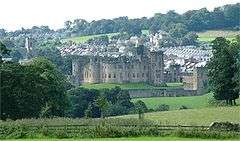 The town of Alnwick, nestling behind Alnwick Castle | |
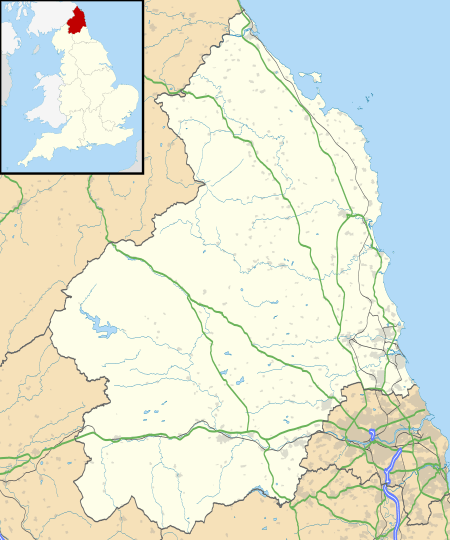 Alnwick Location within Northumberland | |
| Population | 8,116 (2011 census)[1] |
| OS grid reference | NU186129 |
| Unitary authority | |
| Ceremonial county | |
| Region | |
| Country | England |
| Sovereign state | United Kingdom |
| Post town | ALNWICK |
| Postcode district | NE66 |
| Dialling code | 01665 |
| Police | Northumbria |
| Fire | Northumberland |
| Ambulance | North East |
| UK Parliament | |
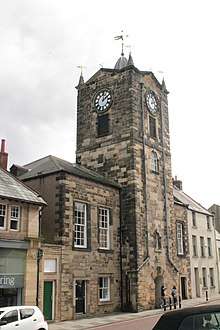
The town is on the south bank of the River Aln, 32 miles (51 km) south of Berwick-upon-Tweed and the Scottish border, 5 miles (8 km) inland from the North Sea at Alnmouth and 34 miles (55 km) north of Newcastle upon Tyne.
The town dates to about AD 600, and thrived as an agricultural centre. Alnwick Castle was the home of the most powerful medieval northern baronial family, the Earls of Northumberland. It was a staging post on the Great North Road between Edinburgh and London, and latterly has become a dormitory town for nearby Newcastle-upon-Tyne . The town centre has changed relatively little, but the town has seen some growth, with several housing estates covering what had been pasture, and new factory and trading estate developments along the roads to the south.
History
The name Alnwick comes from the Old English wic ('dairy farm, settlement') and the name of the river Aln.[2]
The history of Alnwick is the history of the castle and its lords, starting with Gilbert Tyson, written variously as "Tison", "Tisson", and "De Tesson", one of William the Conqueror's standard bearers, upon whom this northern estate was bestowed. It was held by the De Vesci family (now spelt "Vasey" – a name found all over south-east Northumberland) for over 200 years, and then passed into the hands of the house of Percy in 1309.
At various points in the town are memorials of the constant wars between Percys and Scots, in which so many Percys spent the greater part of their lives. A cross near Broomhouse Hill across the river from the castle marks the spot where Malcolm III of Scotland was killed during the first Battle of Alnwick. At the side of the broad shady road called Ratten Row, leading from the West Lodge to Bailiffgate, a stone tablet marks the spot where William the Lion of Scotland was captured during the second Battle of Alnwick (1174) by a party of about 400 mounted knights, led by Ranulf de Glanvill.
Hulne Priory, outside the town walls in Hulne Park, the Duke of Northumberland's walled estate, was a monastery founded in the 13th century by the Carmelites; it is said that the site was chosen for some slight resemblance to Mount Carmel where the order originated. Substantial ruins remain.
In 1314, Sir John Felton was governor of Alnwick.[3] In winter 1424, much of the town was burnt by a Scottish raiding party. Again in 1448 the town was burnt by a Scottish army led by William Douglas, 8th Earl of Douglas and George Douglas, 4th Earl of Angus. There was a Church of Scotland congregation in Alnwick in the 17th and 18th centuries.[4]
Thomas Malory mentions Alnwick as a possible location for Lancelot's castle Joyous Garde.
An Royal Air Force distribution depot was constructed at Alnwick during the Second World War war with four main fuel storage tanks (total capacity 1700 tons), and road and rail loading facilities. The tanks were above ground and surrounded with concrete. The site was closed in the 1970s and its demolition and disposal was completed in 1980. [5]
The Alnwick by-pass takes the A1 London–Edinburgh trunk road around the town. It was started in 1968.[6]
Geography
Alnwick lies at 55°25′00″N 01°42′00″W (55.417, -1.700)1. The River Aln forms its unofficial northern boundary.
Governance
Historically, the town was partly within the Bamburgh Ward and Coquetdale Ward and later included in the East Division of Coquetdale Ward in 1832.[7] By the time of the 2011 Census an electoral ward covering only part of Alnwick Parish name existed. The total population of this ward was 4,766.[8]
Economy

Formerly a largely rural and agrarian community, the town now lies within the "travel to work" radius of Morpeth and Newcastle upon Tyne and has a sizeable commuter population. Some major or noteworthy employers in the town are:
- Metrology Software Products Ltd, developers and suppliers of co-ordinate measuring machine and machine tool software
- House of Hardy, makers of fly-fishing tackle
- Greys of Alnwick, makers of fly-fishing tackle
- Northumberland Estates, which manages the Duke of Northumberland's agricultural, forestry and property interests
- Barter Books, one of the largest second-hand book shops in England, set in the town's former railway station
- Sanofi Alnwick Research Centre, a large pharmaceutical research and testing centre
- NFU Mutual, provider of insurance, pensions, investments
- DEFRA (Department for Environment Food and Rural Affairs)[9]
- Skin Salveation manufacturers and distributors of skin care products
Landmarks
The town's greatest building is Alnwick Castle, one of the homes of the Duke of Northumberland, and site of The Alnwick Garden; it dominates the west of the town, above the River Aln. The castle is the hub of a number of commercial, educational and tourism operations. From 1945 to 1975, it was the location of a teacher training college for young women and "mature students" (persons of more than 21 years in age). Currently, it houses American students studying in Europe through a partnership with Saint Cloud State University; it is the base of Northumberland Estates, the Duke's commercial enterprise; and is in its own right a tourist attraction. The castle is open to tourists from April to September, and the Gardens all year around. It is the second largest inhabited castle in England, after Windsor Castle. Benjamin Disraeli describes Alnwick as "Montacute" in his novel Tancred.
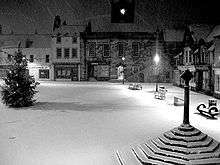
The centre of town is the market place, with its market cross, and the relatively modern Northumberland Hall, used as a meeting place. Surrounding the market place are the main shopping streets: Narrowgate, Fenkle Street, and Bondgate Within. The last of these is a wide road fronted by commercial buildings. In medieval times, Alnwick was a walled town, although due to fluctuating economic conditions during the Middle Ages, the walls were never completed. Hotspur Tower, a medieval gate, is extant, dividing Bondgate Within from Bondgate Without, and restricting vehicles to a single lane used alternately in each direction. Pottergate Tower, at the other side of the town, also stands on the site of an ancient gate, but the tower itself was rebuilt in the 18th century. Its ornate spire was destroyed in a storm in 1812. Outside the line of the walls, the old railway station building is relatively ostentatious for such a small town, due to its frequent use by royal travellers visiting Alnwick Castle. It is now a large secondhand bookshop.
The town has a thriving playhouse, a multi-purpose arts centre, which stages theatre, dance, music, cinema, and visual arts productions.
In 2003, the Willowburn Sports and Leisure Centre was opened on the southern outskirts of the enlarged town (replacing the old sports centre located by the Lindisfarne Middle School and the now-demolished Youth Centre). More widely, the Alnwick district boasts a wealth of sporting and leisure facilities, including football, cricket, rugby, rambling, rock climbing, water sports, cycling and horse riding. Golfers can find thirteen golf courses within 30 minutes drive of the town.
The castle is popular with film-makers: Blackadder, Robin Hood: Prince of Thieves and Harry Potter; are some of the films shot here.
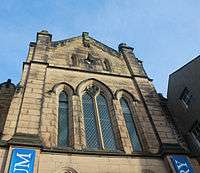
Alnwick's museum, Bailiffgate Museum, is close to the Bailiffgate entrance to the castle. Its collection is specifically dedicated to local social history. The museum has recently had a major refit funded by the Heritage Lottery Fund. Its collection includes a variety of agricultural objects, domestic items, railway items, coal mining artefacts, printing objects, a sizeable photographic collection, paintings and a range of activities for children.[10] Local artist Stella Vine donated three of her paintings to the museum, as she had grown up in Alnwick.
Other places of interest in and near the town include:

- Brizlee Tower, a Grade 1 listed folly tower on a hill in Hulne Park, the Duke's walled estate, designed by Robert Adam in 1777 and erected in 1781 for Hugh Percy, 1st Duke of Northumberland.
- Camphill Column, an 1814 construction celebrating British victories in Europe, and possibly erected as a reaction against the French Revolution.
- the Hotspur Tower, part of the remains of the ancient town wall, and named after Sir Henry Percy, also called Harry Hotspur, the eldest son of the 1st Earl of Northumberland and a major character in Henry IV, Part 1.
- the Nelson Memorial, Swarland, emphasising a local link to the admired Admiral.
- the Tenantry Column—much in the style of Nelson's Column, 83 feet (25 m) tall and topped by the Percy Lion, symbol of the Percy family—designed by Charles Harper and erected for Hugh Percy, 2nd Duke of Northumberland in 1816 in gratitude to the Duke. A popular urban legend states that, in response to this display of wealth, the Duke immediately increased the tenants' rent. In reality the later rent increase was under his successor, the 3rd Duke of Northumberland.
- the White Swan Hotel, an 18th-century coaching inn that now houses the First Class Lounge and other fittings from the Titanic's near identical sister ship RMS Olympic.
- the Fusiliers Museum of Northumberland, found within Alnwick Castle.
- the Pinfold, a stone circular structure within the centre of the town, built as a pound for stray cattle.
- St Michael's Church on Bailiffgate, a grade II listed building dating from the 15th century with fragments from the 12th century.
- RAF Boulmer was an airfield during World War II. It now has a role in early warning radar surveillance and communications.
- The Fenkle Street drill hall converted from a library in 1887.[11]
Events
Major events in the Alnwick calendar include:
- Shrove Tuesday football match known as Scoring the Hales is played in the Pastures (the fields below the castle) between the parishes of St Paul and St Michael. The ball is brought from Alnwick Castle in procession, preceded by the Duke of Northumberland's piper. The first team to score two "hales" (goals) wins.
- Saturday Markets in Alnwick Market Square from Jan - Dec
- Thursday & Saturday Markets, fresh local produce, arts and crafts, jewellery, soft furnishings and household items (Thursday Markets are seasonal, starting in March)
- Easter Market in Alnwick Market Square, children's entertainment and lots of local fresh produce
- Alnwick Castle Tournament – a medieval jousting spectacular in the grounds of Alnwick Castle
Alnwick Fair was an annual costumed event, held each summer from 1969 to 2007, recreating some of the appearance of medieval trading fairs and 17th century agricultural fairs. It has now been discontinued.[12]
Transport
Road
Alnwick town lies adjacent to the A1, the main national north/south trunk road, providing easy access to Newcastle upon Tyne (35 miles (56 km) south) and to the Scottish capital Edinburgh (80 miles (130 km) north). The town is an 'A1 Town', there are several such similar towns in the North of England such as (North to South), Berwick Upon Tweed (28.1 miles North), Morpeth (28.3 miles South), Newton Aycliffe (65.1 miles South) and Wetherby (116 miles South). Being such a stopping point on the A1 (particularly in such a rural area) provides Alnwick with a lot of passing trade and tourism.
Rail
The main East Coast railway link between Edinburgh (journey time approximately 1:10) and London (journey time approximately 3:45) runs via the nearby Alnmouth for Alnwick Station, with a weekday service of 15 trains per day north to Edinburgh and 13 trains per day south to London. Despite its name, Alnmouth Station is located at the western end of the village of Hipsburn, near to the hamlet of Bilton. It also serves the village of Lesbury.
Alnwick was once connected to the main line by the Alnwick branch line, but this was closed in January 1968. The Aln Valley Railway Trust, is in stages, reconstructing the branch as a heritage railway. The Alnwick terminus, called Lionheart station, is located near the Lionheart Enterprise Estate on the outskirts of the town rather than on the site of the original Alnwick railway station closer to the town centre. The building of the A1 bypass makes reopening the section of the line leading into the town centre unviable.
Air
Newcastle Airport lies around 45 minutes drive-time away, and provides 19 daily flights to London (Heathrow, Gatwick, Stansted and London City), with regular flights to other UK centres. The airport also operates regular flights to many European destinations, along with destinations in Africa. Newcastle Airport is the nearest, however for alternative flights, Edinburgh Airport, Leeds Bradford Airport and Manchester Airport are all within 150 miles (240 km).
Town twinning
- Bryne, Norway
- Lagny-sur-Marne, France
- Voerde, Germany
Notable people
Born in Alnwick
- William of Alnwick, (c. 1275–1333), Franciscan theologian and Bishop of Giovinazzo
- Martin of Alnwick, (d. 1336), Franciscan friar and theologian
- Henry 'Hotspur' Percy, (1364?–1403), son of the 1st Earl of Northumberland
- John Busby, (1765–1857), mining engineer
- William Davison (1781–1858) pharmacist, apothecary, printer, etc.
- Prideaux John Selby, (1788–1867), ornithologist, botanist and artist
- William Henry Percy (1788–1855), naval commander and politician.
- George Biddell Airy, (1801–1892), Astronomer Royal from 1835 to 1881
- George Tate, (1805–1871), tradesman, local topographer, antiquarian and naturalist
- Thomas Turner Tate, (1807–1888), mathematical and scientific educator and writer
- James Patterson, Australian Colonial Politician, Premier of Victoria, born in Alnwick in 1833.
- T. J. Cobden Sanderson, (1840–1922), artist and bookbinder associated with the Arts and Crafts movement
- Ralph Tate, (1840–1901), botanist and geologist
- Bernard Bosanquet, (1848–1923), philosopher
- Jim Hilton, (1894–1964), painter for Shell Oil and immigrant to Canada
- David Adam, (b.1936), English minister and Canon of York Minster
- Sid Waddell, (1940–2012), commentator and television personality
- Jeremy Darroch, chief executive of Sky
- Jonny Kennedy, (1966–2003), spokesperson and sufferer of the skin condition Epidermolysis Bullosa
- Stella Vine, (b.1969), artist
Died in Alnwick
- Malcolm III of Scotland – (d.1093)
- Tip Tipping, (1958–1993), actor, died in a parachuting accident
References
- "Parish population 2011". Archived from the original on 26 June 2015. Retrieved 25 June 2015.
- Watts, Victor, ed. (2004). The Cambridge Dictionary of English Place-Names. Cambridge: Cambridge University Press. s.v. Alnwick.
- Stephen, Leslie, ed. (1889). . Dictionary of National Biography. 18. London: Smith, Elder & Co.
- Scott, Hew (1928). Fasti ecclesiae scoticanae; the succession of ministers in the Church of Scotland from the reformation. 7. Edinburgh: Oliver and Boyd. p. 504. Retrieved 8 July 2019.CS1 maint: ref=harv (link)
- Whittle, Tim (2017). Fuelling the Wars - PLUTO and the Secret Pipeline Network 1936 to 2015. p. 207. ISBN 9780992855468.
- Smith, Maurice A, ed. (15 February 1968). "News and Views: A1 Alnwick by-pass". Autocar. p. 57.
- George Tate, The History of the Borough, Castle, and Barony of Alnwick (Vol. 1). Alnwick: Henry Hunter Blair, 1866.
- "Alnwick ward population 2011". Archived from the original on 26 June 2015. Retrieved 25 June 2015.
- "Jobs to go with closure of Alnwick operation". Northumberland Gazette. 11 July 2014. Archived from the original on 2 April 2015. Retrieved 30 March 2015.
- "Bailiffgate Museum". Archived from the original on 5 October 2008. Retrieved 23 December 2008., Retrieved 23 December 2008.
- "Kelly's Directory of Northumberland (1894)". Archived from the original on 28 August 2016. Retrieved 8 July 2017.
- Curry, Jaclyn (14 February 2008). "Death of the Fair". Northumberland Gazette. Northumberland. Archived from the original on 16 February 2008. Retrieved 23 August 2010.
External links
| Wikivoyage has a travel guide for Alnwick. |
| Wikimedia Commons has media related to Alnwick. |
- Visit Alnwick – Alnwick Tourism Association
- Alnwick described on the Keys to the Past website.
- Alnwick at Curlie
